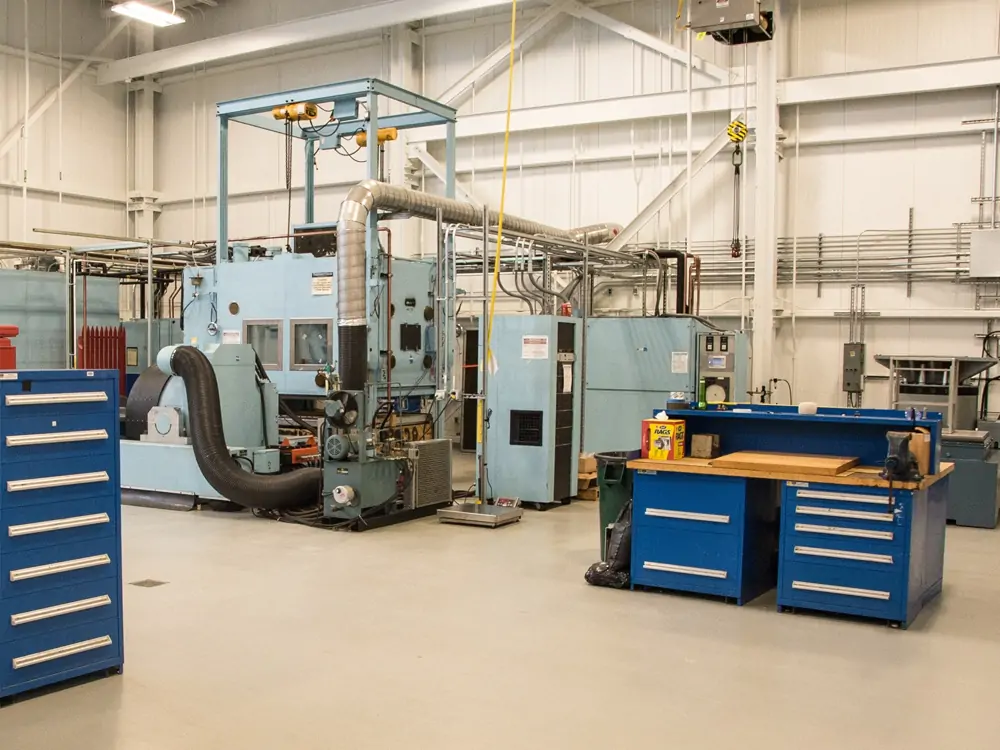How do you trust that your electronic gadgets won’t fail under scorching heat or freezing cold? Would you board a plane if you weren’t sure that all of its vital components had been rigorously tested in extreme temperature conditions? As the world embraces technological advancements, the need for reliability becomes paramount. This is where the mysterious world of thermal shock testing comes into play – a method that pushes a product to its limits and reveals its true mettle in the face of drastic temperature changes.
In this article, we will dive into the captivating world of thermal shock testing. We will learn about its significance. And how it illuminates the strengths and weaknesses of modern marvels. Join us to uncover the secrets hidden in the field of rapid temperature changes.

What Is a thermal shock test?
Thermal shock test is also known as temperature shock test or high and low-temperature shock test. It is mainly used to assess the adaptability of products to rapid changes in ambient temperature. It is to expose the test sample to alternately low-temperature and high-temperature air (or suitable inert gas). The rapid changes can influence the sample. So, this is an indispensable test in the equipment design qualification test and routine test in the mass production stage. Sometimes, this test can also serve as an environmental stress screening test.
Purpose of thermal shock test
The purpose of a thermal shock test is to assess the ability of a product or material to withstand rapid and extreme temperature changes without experiencing failure or degradation.
The main objectives of thermal shock testing are as follows:
Identify Potential Weaknesses:
Rapid temperature changes can cause materials to expand or contract at different rates. This creates mechanical stress and strain. Thermal shock testing helps identify weak points, such as cracks, delamination or material degradation. It helps manufacturers identify potential product weaknesses and vulnerabilities early on when exposed to rapid temperature changes. Then they can improve and optimize before selling. Reduce unnecessary losses.
Evaluating Material Properties, Compatibility And Component Performance:
Different materials have varying thermal expansion coefficients, thermal conductivities and mechanical properties. This test allows people to evaluate and compare the performance of different materials under extreme temperature conditions. It also helps to assess material compatibility. And identify potential issues due to differences in expansion. Manufacturers can also check the performance of individual components under extreme temperature conditions. Manufacturers can use this information to make informed design decisions and improvements.
Determine And Improve Product Reliability
Thermal shock testing helps manufacturers assess whether their products can withstand thermal cycling stresses. Confirm whether sudden changes in ambient temperature will affect its intended function. Manufacturers can improve the reliability and longevity of their products by subjecting them to thermal shock testing. Ensuring that products can withstand extreme temperature changes increases customer trust and satisfaction. Because they can be sure that the equipment will operate stably in various environments.
Compliance With Industry Standards:
Many industries, including aerospace, defense, and automotive, have specific standards and regulations that require products to undergo thermal shock testing. By conducting these tests, manufacturers can ensure that their products meet the requirements.
Assess Long-Term Performance:
Manufacturers can gain insights into their products’ long-term performance and reliability by simulating accelerated aging through thermal shock testing. This information is valuable for predicting product lifespans and potential maintenance needs.
Overall, thermal shock testing aims to comprehensively assess a product’s ability to withstand rapid temperature changes. Ensure that it remains functional, safe and reliable throughout its intended use. It helps identify weaknesses, confirm design choices, and enhance the overall quality and performance of products in diverse and challenging environments.

The method of thermal shock test
The thermal shock test is a crucial process in assessing the resistance and durability of products when subjected to rapid and extreme temperature fluctuations. This test is commonly employed in aerospace, automotive, electronics, and defense industries to ensure that devices can withstand harsh environmental conditions without compromising their functionality.
The method of thermal shock testing involves subjecting the product, also known as the Device Under Test (DUT).
Here’s a step-by-step breakdown of the typical thermal shock testing procedure:
- Test Chamber Setup:
The thermal shock test is typically performed in specialized chambers designed for this purpose. These chambers have at least two separate compartments. One for high-temperature exposure and the other for low-temperature exposure. The test chamber should have a pneumatically controlled basket or conveyor system to move the DUT between the hot and cold zones. - Preparation:
Before the test begins, you should carefully inspect the DUT. Ensure it is in proper working condition and free from any defects or damages that could affect the test results. - Basket System:
The DUT is placed in a basket or fixture that allows for rapid movement between the hot and cold zones. The basket may be pneumatically controlled to ensure precise and quick transfers. - Temperature Cycling:
The test begins with the DUT resting in one of the temperature zones. Then, in a controlled and rapid manner, the DUT is transferred to the opposite extreme temperature zone. The time spent in each zone and the number of cycles may vary depending on the testing standards and the product’s intended use. - Monitoring:
Throughout the testing process, various sensors monitor the DUT’s temperature and performance. They collect data at regular intervals. So that they can assess any changes or anomalies during temperature transitions. - Evaluation:
After the specified number of cycles or duration, we remove the DUT from the testing chamber. And then thoroughly evaluate its functionality and structural integrity. This evaluation may involve:
Visual Inspection Functional Testing Performance Analysis - Reporting:
Document test results. It includes any observed failures, changes in performance, or structural damage. These findings help manufacturers understand the product’s limitations and identify areas for improvement.

general standards for thermal shock test
There are several general standards for thermal shock testing. They can ensure test results’ consistency, comparability, and reliability. Recognized organizations often set these standards and are widely followed across industries. Some of the commonly used general standards for thermal shock testing include:
MIL-STD 883K Method 1010.9:
The United States Department of Defense (DoD) published this standard. And it outlines the procedures for testing electronic components, materials, and devices for resistance to thermal shock. This military standard specifies the requirements for thermal shock testing of microelectronic devices. It sets the temperature ranges and the number of cycles required for testing.
All in all, it provides guidelines for test conditions, test equipment, and test methods to assess the product’s ability to withstand rapid temperature changes.
MIL-STD 202H Method 107:
Also published by the U.S. DoD. This military standard provides the test method for the thermal shock resistance of hermetic packages. It details the procedures for subjecting packages to temperature cycling and assessing their ability to withstand thermal shocks without leakage or mechanical failure. This standard focuses on testing the ability of electronic and electrical components to withstand temperature cycling.
MIL-STD-202G:
Another standard from the U.S. DoD. It addresses testing electronic and electrical components for resistance to various environmental conditions. It includes thermal shock test methods and specifies requirements for evaluating test results.
IEC 60068-2-14:
The International Electrotechnical Commission (IEC) published this standard. It specifies methods for testing non-metallic materials’ ability to withstand rapid temperature changes, such as thermal shock. It is widely used in various industries. And it provides guidelines for testing electronic and electrical products.
ASTM E2893:
Developed by the American Society for Testing and Materials (ASTM). ASTM E2893 provides guidelines for conducting thermal shock testing of products, materials, and components. The standard includes procedures for setting test conditions and evaluating the performance of test samples.
JEDEC JESD22-A104:
The JEDEC Solid State Technology Association developed this standard. It focuses on thermal shock testing for integrated circuits. It specifies the test conditions, equipment requirements, and procedures for subjecting ICs to temperature cycling to assess their performance and reliability under thermal shock conditions.
JEDEC JESD22-A106:
The Joint Electron Device Engineering Council (JEDEC) issued this standard. It specifies the test method for determining the thermal shock resistance of semiconductor devices.
Importance of thermal shock test
Thermal shock testing is not just another mundane assessment. It is the crucible where products are forged to withstand the unforgiving forces of nature. This accelerated process puts the resilience of devices to the ultimate test. Ensure they can withstand the harshest temperature swings in the real world. Just imagine. A smartphone that can handle arctic cold and desert heat without compromising its functionality. Or a GPS device that accurately guides explorers across the wilderness no matter how the temperature fluctuates. Thermal shock testing is the behind-the-scenes hero. These remarkable feats are achieved by mimicking the wear and tear of a product during everyday handling or standard use.
For more environmental test chamber, Please visit: https://chiuventionclimatechamber.com
For more environmental test simulation programmes,environmental testing knowledge, instrument knowledge, and environmental testing laboratory knowledge, please contact us: [email protected]